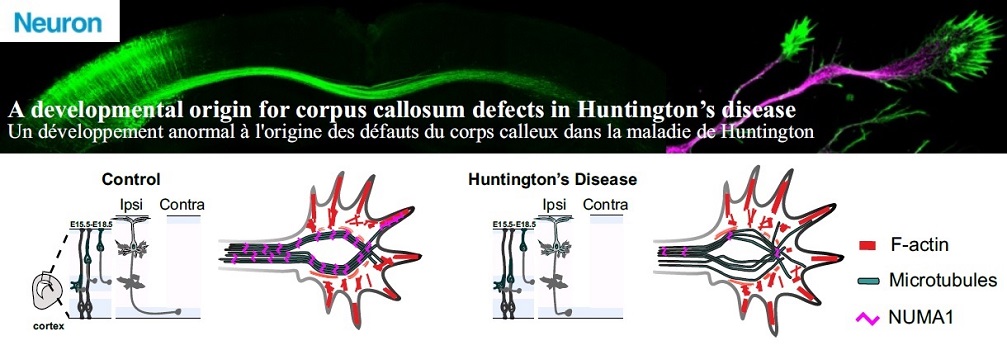- Share
- Share on Facebook
- Share on Twitter
- Share on LinkedIn
- Share url
On November 23, 2021

Although the classic symptoms of Huntington’s disease (HD) manifest in adulthood, neural progenitor cell behavior is already abnormal by 13 weeks’ gestation. To determine how these developmental defects evolve, we turned to cell and mouse models.We found that layer II/III neurons that normally connect the hemispheres are limited in their growth in HD by microtubule bundling defects within the axonal growth cone, so that fewer axons cross the corpus callosum. Proteomic analyses of the growth cones revealed that NUMA1 (nuclear/mitotic apparatus protein 1) is downregulated in HD by miR-124. Suppressing NUMA1 in wildtype cells recapitulates the microtubule and axonal growth defects of HD, whereas raising NUMA1 levels with antagomiR-124 or stabilizing microtubules with epothilone B restores microtubule organization and rescues axonal growth. NUMA1 therefore regulates the microtubule network in the growth cone, and HD, which is traditionally conceived as a disease of intracellular trafficking, also disturbs the cytoskeletal network.
Référence :
Developmental Defects in Huntington Disease Show that Axonal Growth and Microtubule Reorganization Require NUMA1
Mariacristina Capizzi 1, Rémi Carpentier 1, Eric Denarier 1, Annie Adrait 2, Rayane Kassem 1, Marina Mapelli 3, Yohann Couté 2 and Sandrine Humbert 1
1 Univ. Grenoble Alpes, Inserm, U1216, CEA, Grenoble Institute Neurosciences, 38000 Grenoble, France
2 Univ. Grenoble Alpes, Inserm UMR BioSanté, U1292, CNRS, CEA, FR2048, 38000 Grenoble, France
3 IEO, European Institute of Oncology IRCCS, Via Adamello 16, 20139 Milan, Italy
Date
- Share
- Share on Facebook
- Share on Twitter
- Share on LinkedIn
- Share url